Modeling Impact of Intertidal Foreshore Evolution on Gravel Barrier Erosion and Wave Runup with XBeach-X
Abstract
:1. Introduction
- Pure gravel beaches: Steep slopes () = 0.08–0.24, with average sediment size decreasing from the storm berm down to the swash zone.
- Mixed sand–gravel (MSG): Moderate slopes () = 0.04–0.13, subdivided into beaches with (a) largely intermixed sand and gravel and (b) a higher degree of sorting of sand and gravel in a cross-shore direction.
- Composite beaches: A steep gravel berm with a low-angle intertidal foreshore and well-sorted sand and gravel in the cross-shore direction. Slope values are similar to that of MSG beaches.
- Swash Regime: where wave runup acts on the foreshore without impacting the dune.
- Collision Regime: where exceeds the dune toe. Eroded material is transported off- or alongshore but unlike the swash regime does not return to replenish the barrier.
- Overwash Regime: where exceeds the berm crest, leading to erosion of the dune and deposition inland.
- Inundation Regime: where the barrier becomes completely submerged by a high value and the flows are no longer overwash.
2. Study Site: Newgale, U.K.
3. Modeling Approach
3.1. Storm-Impact Model: XBeach-X
3.2. Wave and Water Level Boundary Conditions
3.3. Cross-Shore Profile
3.4. Updating the Profile with Foreshore Evolution
- The applied gravel grain sizes were set to = and = .
- The porosity factor was set to 0.45.
- The model’s white-colebrook-grainsize parameter was enabled, instructing the model to derive a bed friction coefficient based on the applied .
- The model’s groundwater exchange mechanism was enabled (gwflow).
4. Results
- Freeboard: Calculated as the difference in elevation between the barrier crest and at intervals when the water level exceeds the toe of the barrier ( m ODN). is calculated using the runup gauge output function in XBeach-X. Freeboard values are set to zero when exceeds the barrier crest. The calculation of freeboard accounts for any lowering of the barrier crest throughout the simulation, whereas using alone would neglect this.
- Relative wave runup (), where is one-minute averaged.
- Elevation change of the managed barrier crest (): Calculated by integrating cumulative elevation change across the cross-shore area equal to or above 7 m ODN (the height at which the management policy dictates that 4 to 5 barrier width should be maintained) at one-minute intervals. The morphologic response enters the overwash regime as begins to rival the barrier crest.
- Elevation change of the barrier crest (): One-minute averaged change of the maximum height of the barrier.
- Elevation change of the barrier toe (): Calculated by integrating cumulative elevation change across the cross-shore area between the barrier toe and 5 offshore of the barrier toe at one-minute intervals
- Back-barrier sedimentation (): Calculated by integrating cumulative elevation change across the area between the base of the back barrier and the landwards boundary of the model at one-minute intervals.
- Iribarren Number (, [48]) to determine the type of breaking wave: Calculated using Equation (1):where is the deep water wavelength, g = / and is the beach slope (area between the barrier crest (x = 0 ) and the grid cell which experiences the deepest scour (x = ). Values >3.3 represent surging/collapsing waves and values <3.3 represent plunging waves. The spilling wave regime, characterized by values of < 0.5 are not shown to occur due to the steep nature of the beach.
4.1. Freeboard and Relative Wave Runup under Applied Foreshore Evolution Settings
4.2. Barrier Change under Applied Foreshore Evolution Settings
4.3. Temporal Change in the Iribarren Number under Applied Foreshore Evolution Settings
5. Discussion
5.1. Impact of Foreshore Evolution on Wave Hazard and Erosion
5.2. Implications for Modeling Applications on Composite Gravel Beaches
5.3. Limitations
6. Conclusions
Author Contributions
Funding
Acknowledgments
Conflicts of Interest
References
- Masselink, G.; Scott, T.; Poate, T.; Russell, P.; Davidson, M.; Conley, D. The extreme 2013/2014 winter storms: Hydrodynamic forcing and coastal response along the southwest coast of England. Earth Surf. Process. Landf. 2016, 41, 378–391. [Google Scholar] [CrossRef] [Green Version]
- Tamarin, T.; Kaspi, Y. The poleward shift of storm tracks under global warming: A Lagrangian perspective. Geophys. Res. Lett. 2017, 44, 10666–10674. [Google Scholar] [CrossRef]
- Vitousek, S.; Barnard, P.L.; Fletcher, C.H.; Frazer, N.; Storlazzi, C.D. Doubling of coastal flooding frequency within decades due to sea-level rise. Sci. Rep. 2017, 7, 1399. [Google Scholar] [CrossRef]
- Moses, C.A.; Williams, R.B.G. Artificial beach recharge: The South East England experience. Z. Fur Geomorphol. Suppl. Issues 2008, 52, 107–124. [Google Scholar] [CrossRef]
- McCall, R.; de Vries, J.V.T.; Plant, N.; Dongeren, A.V.; Roelvink, J.; Thompson, D.; Reniers, A. Two-dimensional time dependent hurricane overwash and erosion modeling at Santa Rosa Island. Coast. Eng. 2010, 57, 668–683. [Google Scholar] [CrossRef]
- Lorenzo-Trueba, J.; Ashton, A.D. Rollover, drowning, and discontinuous retreat: Distinct modes of barrier response to sea-level rise arising from a simple morphodynamic model. J. Geophys. Res. Earth Surf. 2014, 119, 779–801. [Google Scholar] [CrossRef] [Green Version]
- Mellett, C.L.; Plater, A.J. Drowned Barriers as Archives of Coastal-Response to Sea-Level Rise. In Barrier Dynamics and Response to Changing Climate; Moore, L.J., Murray, A.B., Eds.; Springer International Publishing: Cham, Switzerland, 2018; pp. 57–89. [Google Scholar] [CrossRef]
- Jennings, R.; Shulmeister, J. A field based classification scheme for gravel beaches. Mar. Geol. 2002, 186, 211–228. [Google Scholar] [CrossRef]
- Roelvink, D.; Reniers, A.; van Dongeren, A.; van Thiel de Vries, J.; McCall, R.; Lescinski, J. Modelling storm impacts on beaches, dunes and barrier islands. Coast. Eng. 2009, 56, 1133–1152. [Google Scholar] [CrossRef]
- Grases, A.; Gracia, V.; García-León, M.; Lin-Ye, J.; Sierra, J.P. Coastal Flooding and Erosion under a Changing Climate: Implications at a Low-Lying Coast (Ebro Delta). Water 2020, 12, 346. [Google Scholar] [CrossRef] [Green Version]
- Phillips, B.T.; Brown, J.M.; Bidlot, J.R.; Plater, A.J. Role of beach morphology in wave overtopping hazard assessment. J. Mar. Sci. Eng. 2017, 5, 1. [Google Scholar] [CrossRef] [Green Version]
- Dissanayake, P.; Brown, J.; Wisse, P.; Karunarathna, H. Effects of storm clustering on beach/dune evolution. Mar. Geol. 2015, 370, 63–75. [Google Scholar] [CrossRef]
- McCall, R.; Masselink, G.; Poate, T.; Roelvink, J.; Almeida, L. Modelling the morphodynamics of gravel beaches during storms with XBeach-G. Coast. Eng. 2015, 103, 52–66. [Google Scholar] [CrossRef]
- Poate, T.G.; McCall, R.T.; Masselink, G. A new parameterisation for runup on gravel beaches. Coast. Eng. 2016, 117, 176–190. [Google Scholar] [CrossRef] [Green Version]
- Stockdon, H.; Holman, R.; Howd, P.; Sallenger, A.H., Jr. Empirical parameterization of setup, swash, and runup. Coast. Eng. 2006, 53, 573–588. [Google Scholar] [CrossRef]
- Sallenger, A.H., Jr. Storm impact scale for barrier islands. J. Coast. Res. 2000, 16, 890–895. [Google Scholar]
- Plomaritis, T.A.; Ferreira, Ã.; Costas, S. Regional assessment of storm related overwash and breaching hazards on coastal barriers. Coast. Eng. 2018, 1, 124–133. [Google Scholar] [CrossRef]
- Donnelly, C.; Larson, M.; Hanson, H. A numerical model of coastal overwash. Proc. Inst. Civ. Eng.-Marit. Eng. 2009, 162, 105–114. [Google Scholar] [CrossRef] [Green Version]
- Brown, S.I.; Dickson, M.E.; Kench, P.S.; Bergillos, R.J. Modelling gravel barrier response to storms and sudden relative sea-level change using XBeach-G. Mar. Geol. 2019, 4, 164–175. [Google Scholar] [CrossRef]
- Bergillos, R.J.; Masselink, G.; Ortega-Sánchez, M. Coupling cross-shore and longshore sediment transport to model storm response along a mixed sand-gravel coast under varying wave directions. Coast. Eng. 2017, 129, 93–104. [Google Scholar] [CrossRef] [Green Version]
- Bergillos, R.J.; Rodríguez-Delgado, C.; Ortega-Sánchez, M. Advances in management tools for modeling artificial nourishments in mixed beaches. J. Mar. Syst. 2017, 1, 1–13. [Google Scholar] [CrossRef]
- Pollard, J.; Spencer, T.; Brooks, S.; Christie, E.; Möller, I. Understanding spatio-temporal barrier dynamics through the use of multiple shoreline proxies. Geomorphology 2020, 3, 107058. [Google Scholar] [CrossRef]
- McCall, R.T.; Masselink, G.; Poate, T.G.; Roelvink, J.A.; Almeida, L.P.; Davidson, M.; Russell, P.E. Modelling storm hydrodynamics on gravel beaches with XBeach-G. Coast. Eng. 2014, 91, 231–250. [Google Scholar] [CrossRef] [Green Version]
- Jamal, M.; Simmonds, D.; Magar, V. Modelling gravel beach dynamics with XBeach. Coast. Eng. 2014, 89, 20–29. [Google Scholar] [CrossRef]
- Masselink, G.; McCall, R.; Poate, T.; van Geer, P. Modelling storm response on gravel beaches using XBeach-G. Proc. ICE Marit. Eng. 2014, 167, 173–191. [Google Scholar] [CrossRef] [Green Version]
- Royal Haskoning DHV. Newgale Shingle Bank Vulnerability Assessment; Technical Report; Haskoning DHV Ltd.: Peterborough, UK, 2014. [Google Scholar]
- ESRI. World Imagery; ESRI: Redlands, CA, USA, 2020. [Google Scholar]
- Natural Resources Wales. Shoreline Management Plan (SMP) 2; Natural Resources Wales: Cardiff, UK, 2019. [Google Scholar]
- Telegraph. Newgale Beach, Pembrokeshire. Telegraph. 2019. Available online: https://www.telegraph.co.uk/travel/galleries/britains-best-shingle-beaches/newgale-beach-pembrokeshire/ (accessed on 10 November 2020).
- Western Telegraph. Managed Retreat from Newgale ‘in Next 60 Years’. Western Telegraph. 2014. Available online: https://www.westerntelegraph.co.uk/news/11083509.managed-retreat-from-newgale-in-next-60-years/ (accessed on 10 November 2020).
- Prime, T.; Brown, J.M.; Plater, A.J. Flood inundation uncertainty: The case of a 0.5% annual probability flood event. Environ. Sci. Policy 2016, 59, 1–9. [Google Scholar] [CrossRef] [Green Version]
- Bendoni, M.; Georgiou, I.; Roelvink, D.; Oumeraci, H. Numerical modelling of the erosion of marsh boundaries due to wave impact. Coast. Eng. 2019, 152, 103514. [Google Scholar] [CrossRef]
- Garzon, J.L.; Miesse, T.; Ferreira, C.M. Field-based numerical model investigation of wave propagation across marshes in the Chesapeake Bay under storm conditions. Coast. Eng. 2019, 146, 32–46. [Google Scholar] [CrossRef]
- Splinter, K.D.; Carley, J.T.; Golshani, A.; Tomlinson, R. A relationship to describe the cumulative impact of storm clusters on beach erosion. Coast. Eng. 2014, 83, 49–55. [Google Scholar] [CrossRef]
- Dongeren, A.V.; Lowe, R.; Pomeroy, A.; Minh, D.; Roelvink, D.; Symonds, G.; Ranasinghe, R. Numerical modeling of low-frequency wave dynamics over a fringing coral reef. Coast. Eng. 2013, 73, 178–190. [Google Scholar] [CrossRef]
- Quataert, E.; Storlazzi, C.; Rooijen, A.; Cheriton, O.; Dongeren, A. The influence of coral reefs and climate change on wave-driven flooding of tropical coastlines. Geophys. Res. Lett. 2015, 6407–6415. [Google Scholar] [CrossRef]
- Williams, J.J.; de Alegría-Arzaburu, A.R.; McCall, R.T.; Van Dongeren, A. Modelling gravel barrier profile response to combined waves and tides using XBeach: Laboratory and field results. Coast. Eng. 2012, 63, 62–80. [Google Scholar] [CrossRef]
- Van Rijn, L.C. A simple general expression for longshore transport of sand, gravel and shingle. Coast. Eng. 2014, 90, 23–39. [Google Scholar] [CrossRef]
- Lyddon, C.; Brown, J.M.; Leonardi, N.; Plater, A.J. Flood Hazard Assessment for a Hyper-Tidal Estuary as a Function of Tide-Surge-Morphology Interaction. Estuaries Coasts 2018, 41, 1565–1586. [Google Scholar] [CrossRef] [Green Version]
- CEFAS. WaveHindcast. (Note: The WaveWatchIII data is Provided by the U.K. Met Office and Hosted by the Centre for Environment, Fisheries and Aquaculture Science (CEFAS) on a Platform Funded by the Environment Agency.). Available online: http://wavenet.cefas.co.uk/hindcast (accessed on 29 September 2010).
- Hasselmann, K.; Barnett, T.; Bouws, E.; Carlson, H.; Cartwright, D.; Enke, K.; Ewing, J.; Gienapp, H.; Hasselmann, D.; Kruseman, P.; et al. Measurements of wind-wave growth and swell decay during the Joint North Sea Wave Project (JONSWAP). Dtsch. Hydrogr. Inst. 1973, 8, 1–95. [Google Scholar]
- National Oceanography Centre. POLTIPS-3 Coastal Tidal Software; National Oceanography Centre: Liverpool, UK, 2016. [Google Scholar]
- National Tidal and Sea Level Facility. Highest & Lowest Predicted Tides at Milford Haven; National Tidal and Sea Level Facility: Liverpool, UK, 2019. [Google Scholar]
- Natural Resources Wales. LiDAR Dataset Wales. Available online: https://libcat.naturalresources.wales/webview/?tiarray=full&oid=116814 (accessed on 14 August 2020).
- Hallermeier, R.J. A profile zonation for seasonal sand beaches from wave climate. Coast. Eng. 1981, 4, 253–277. [Google Scholar] [CrossRef]
- OceanWise. 1 Arcsecond Bathymetry—Marine Themes Digital Elevation Model (DEM). Available online: https://digimap.edina.ac.uk/webhelp/marine/data_information/products_available/1_arcsecond_bathymetry.htm (accessed on 15 September 2020).
- Deltares. XBeach Toolbox. Available online: https://repos.deltares.nl/repos/OpenEarthTools/trunk/matlab/applications/xbeach/ (accessed on 22 October 2020).
- Battjes, J. Surf Similarity. In Proceedings of the 14th International Conference on Coastal Engineering 1974, Copenhagen, Denmark, 24–28 June 1974; pp. 466–480. [Google Scholar] [CrossRef]
- Dornbusch, U. Design requirement for mixed sand and gravel beach defences under scenarios of sea level rise. Coast. Eng. 2017, 124, 12–24. [Google Scholar] [CrossRef]
- Pianosi, F.; Beven, K.; Freer, J.; Hall, J.W.; Rougier, J.; Stephenson, D.B.; Wagener, T. Sensitivity analysis of environmental models: A systematic review with practical workflow. Environ. Model. Softw. 2016, 79, 214–232. [Google Scholar] [CrossRef]
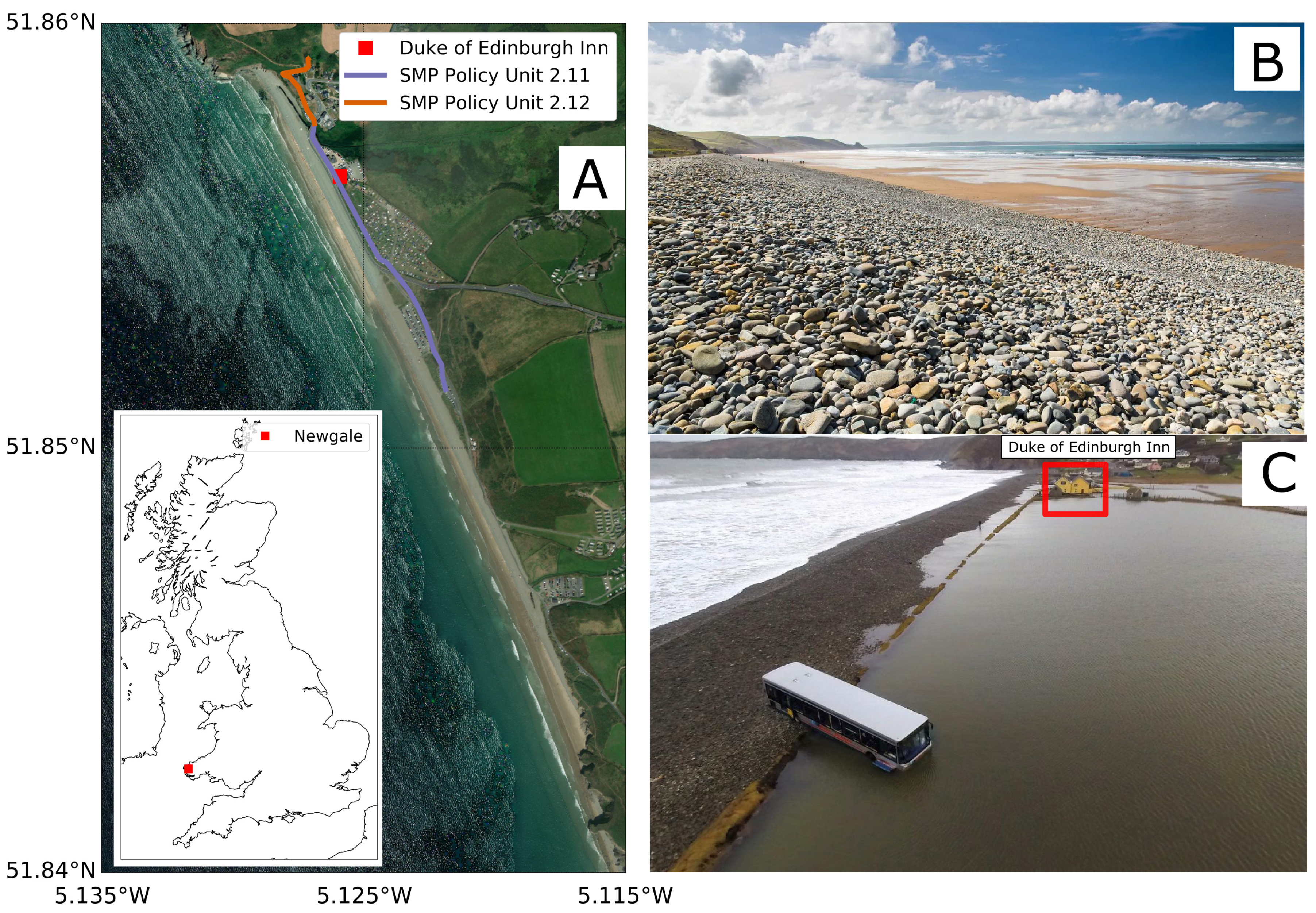
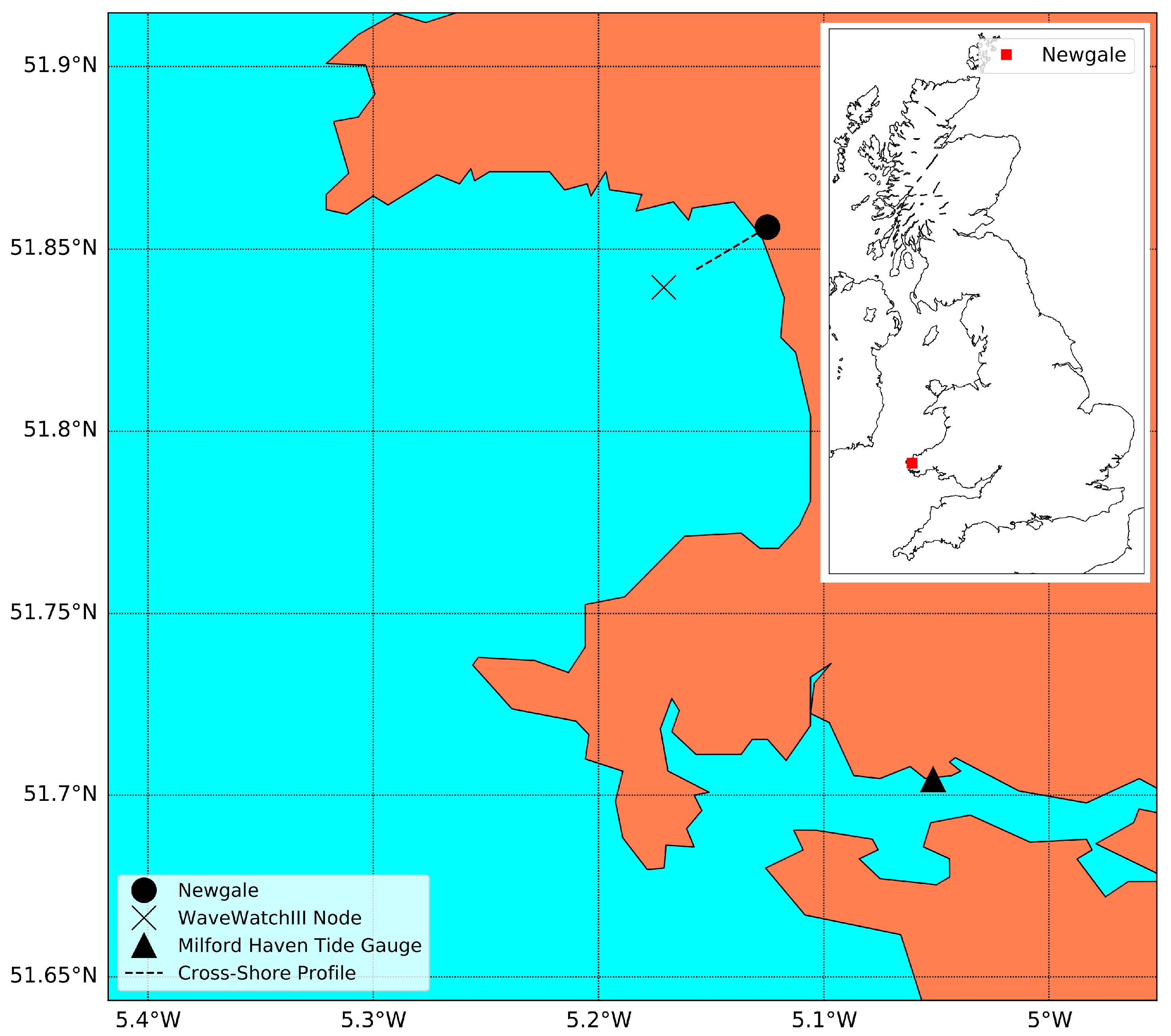
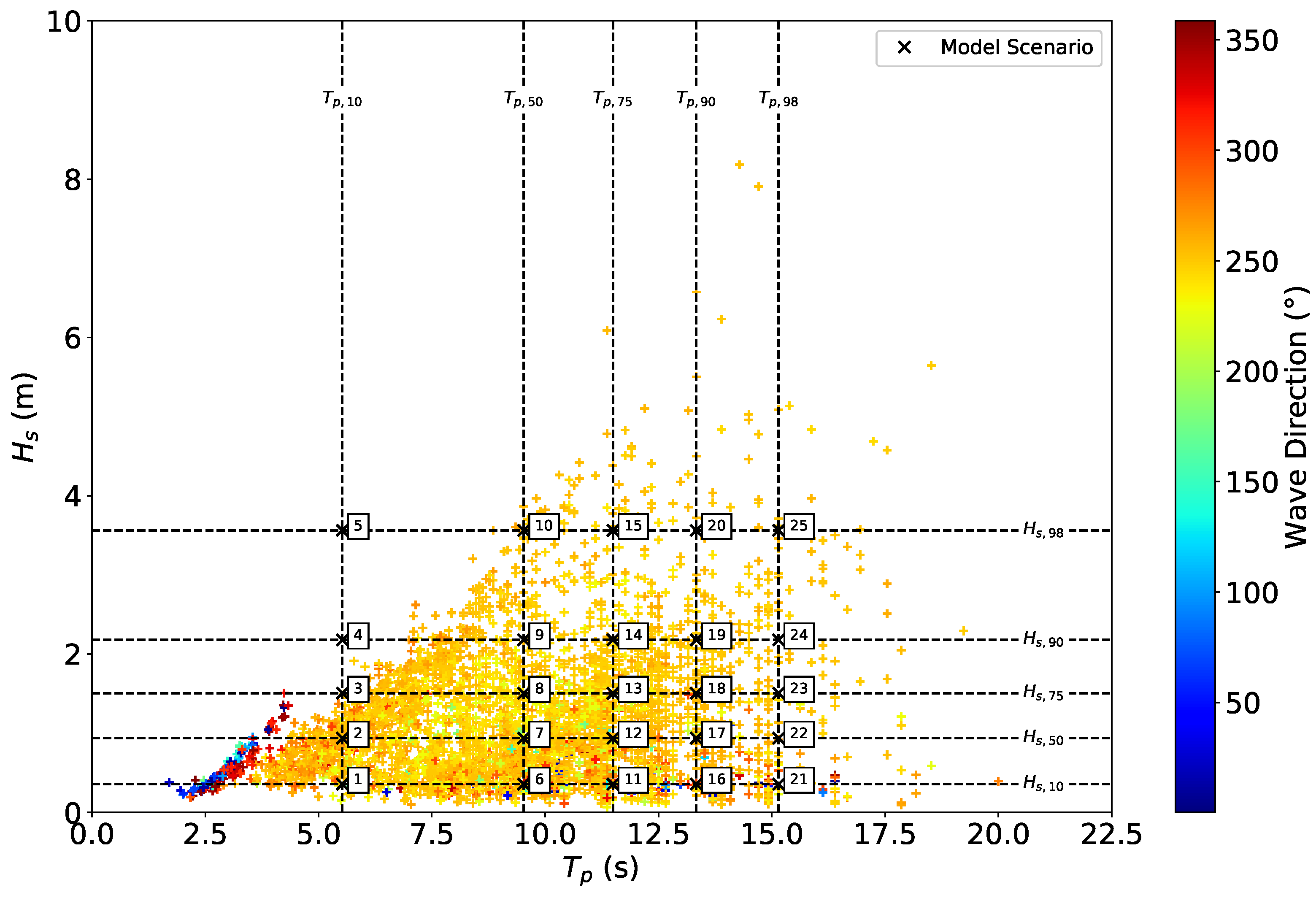
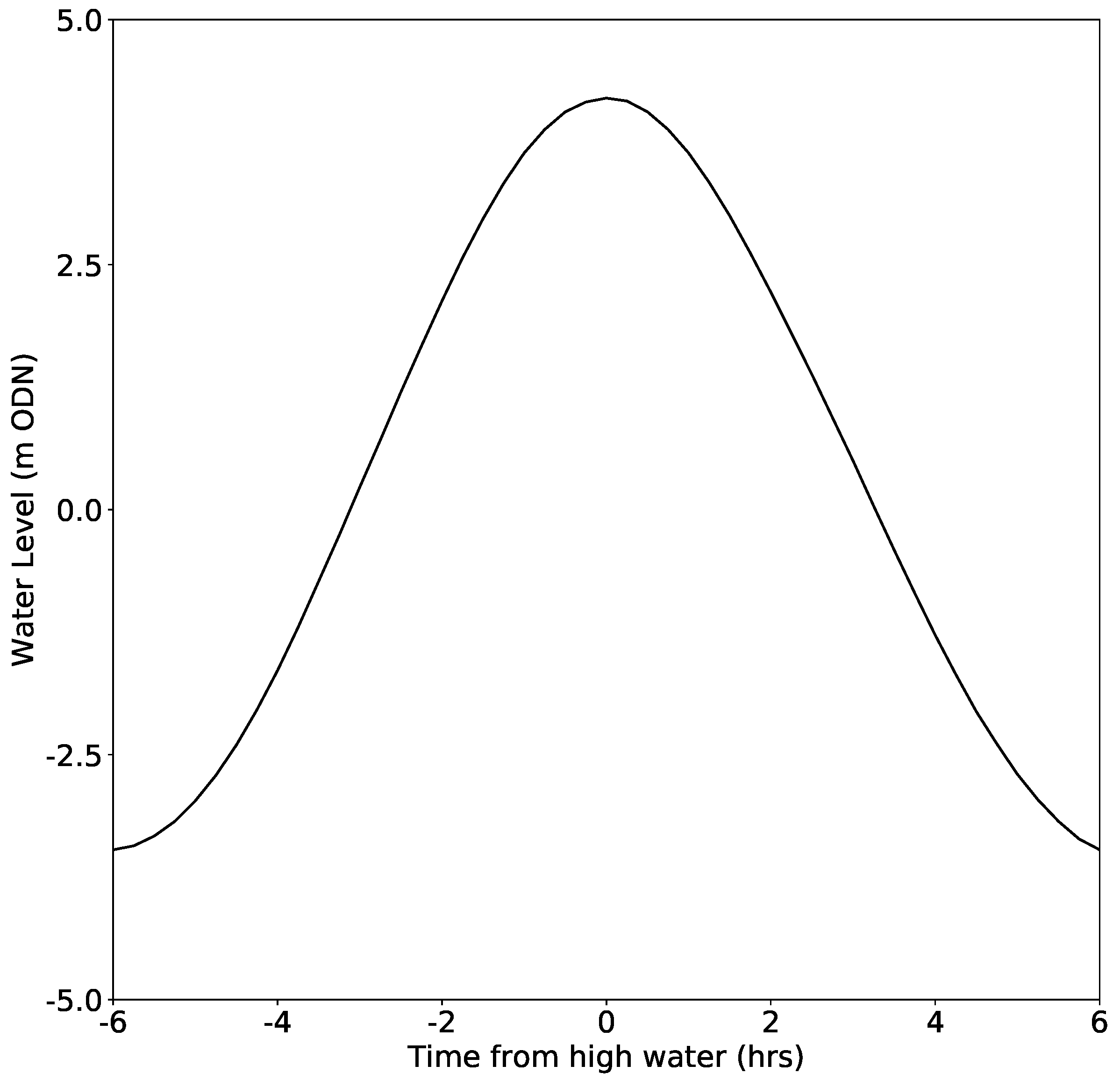
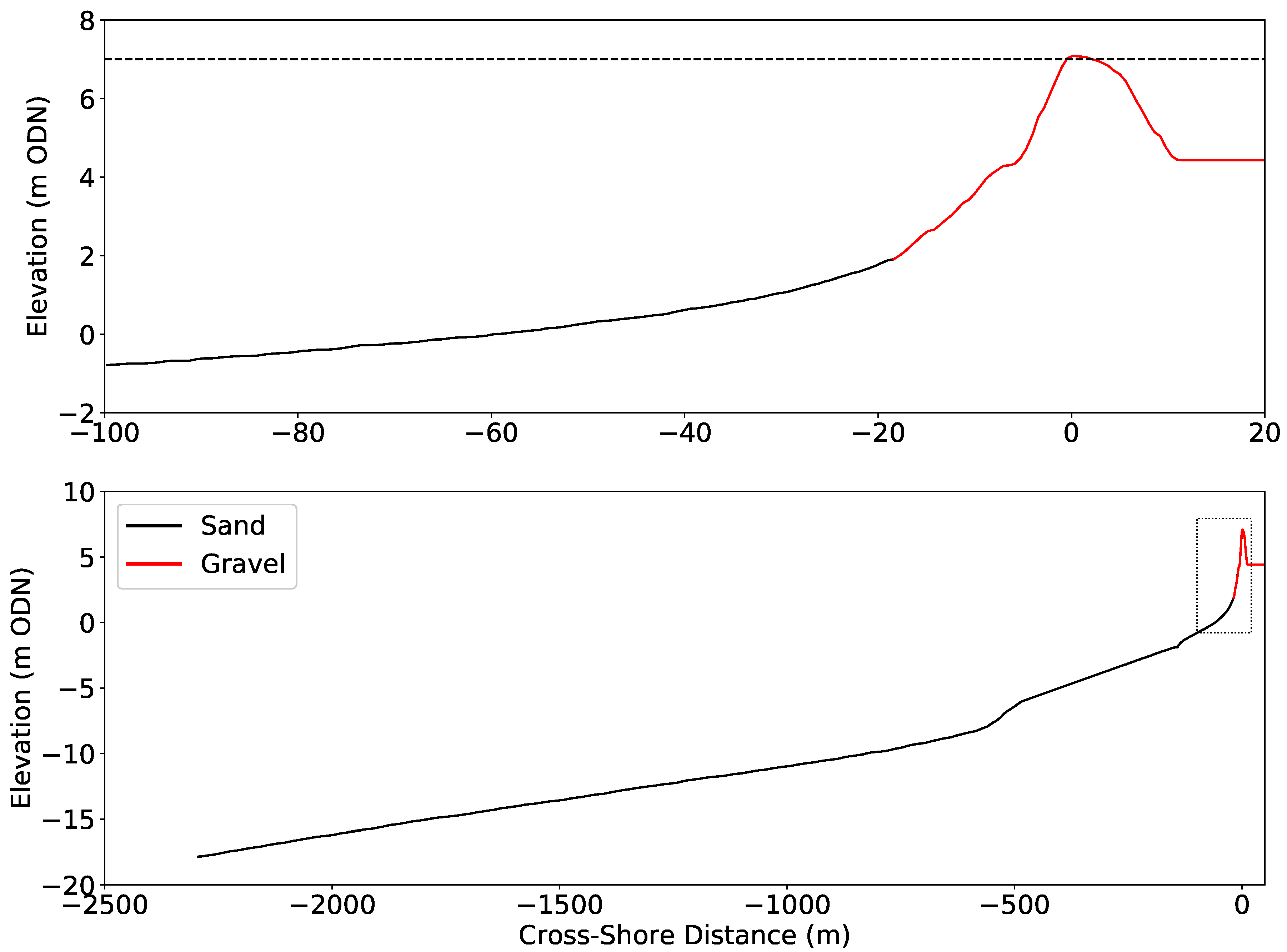
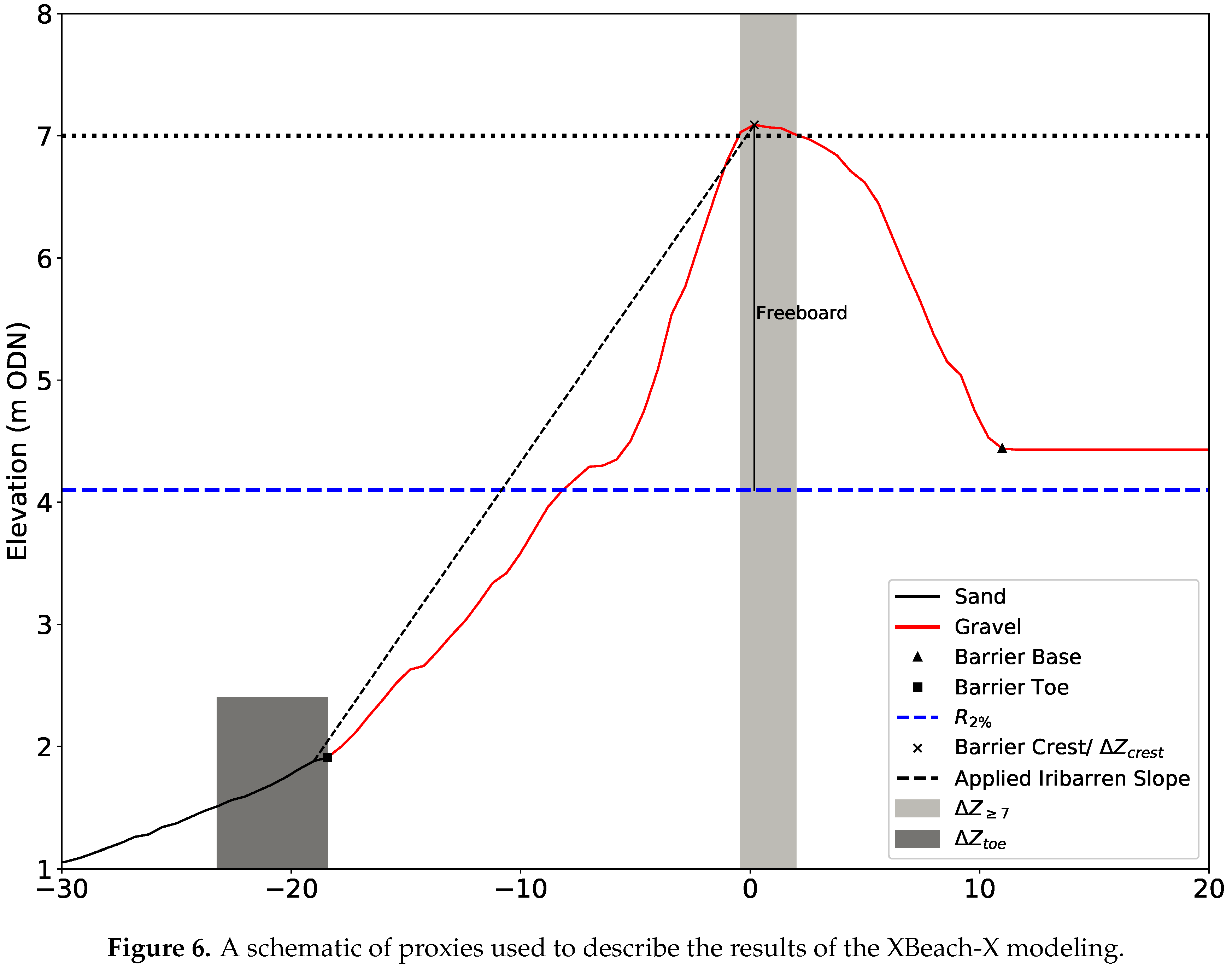
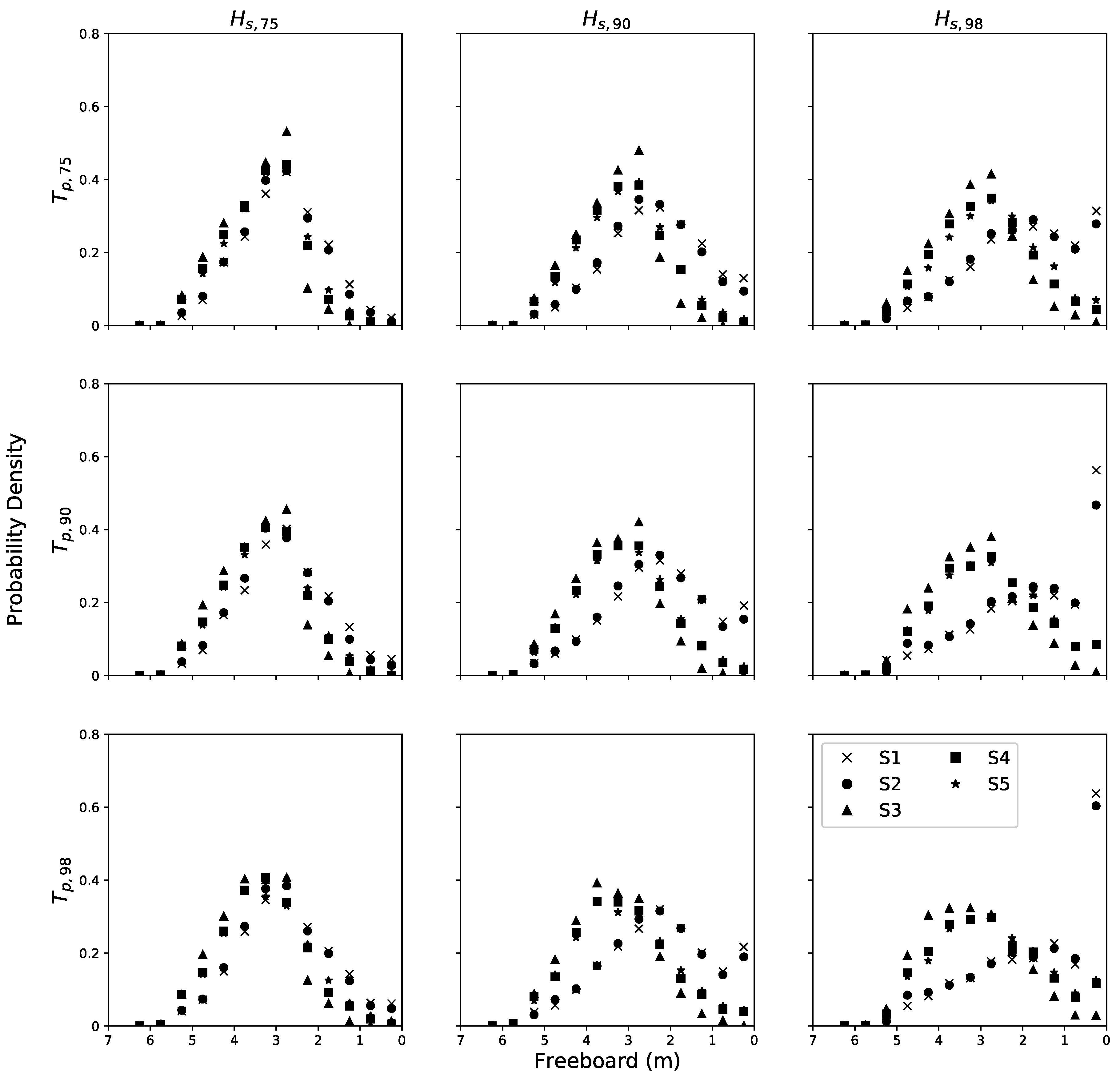
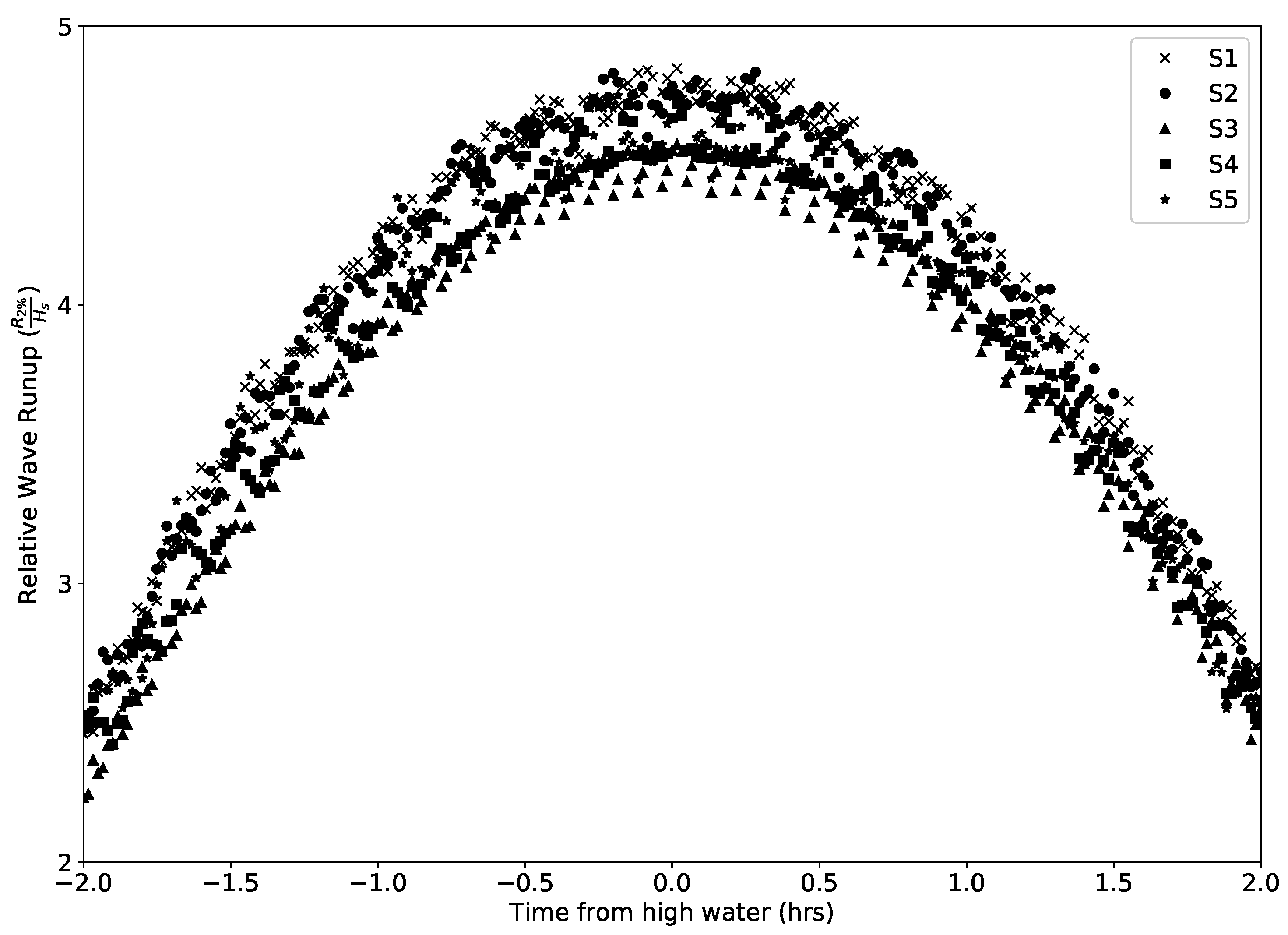
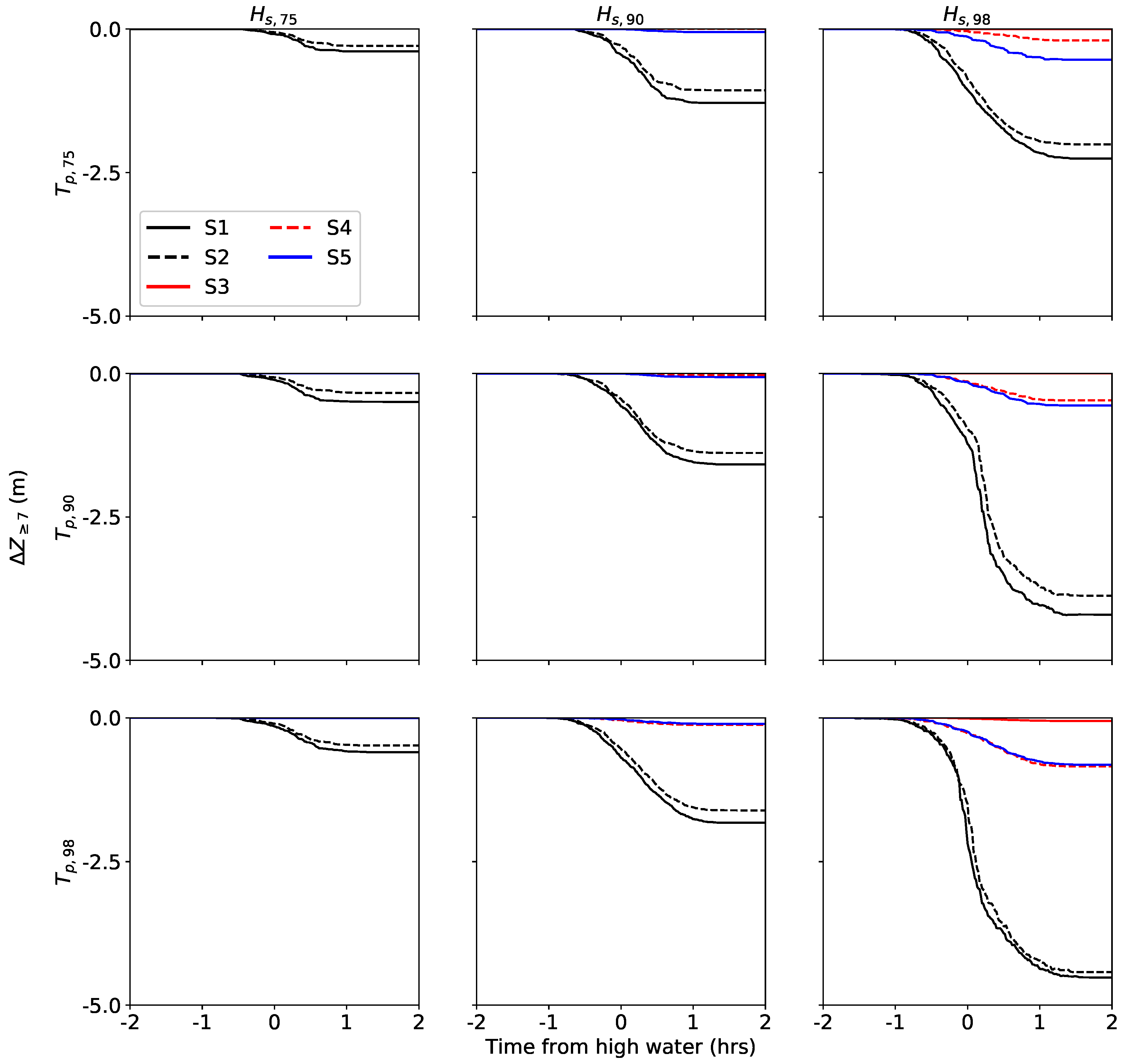
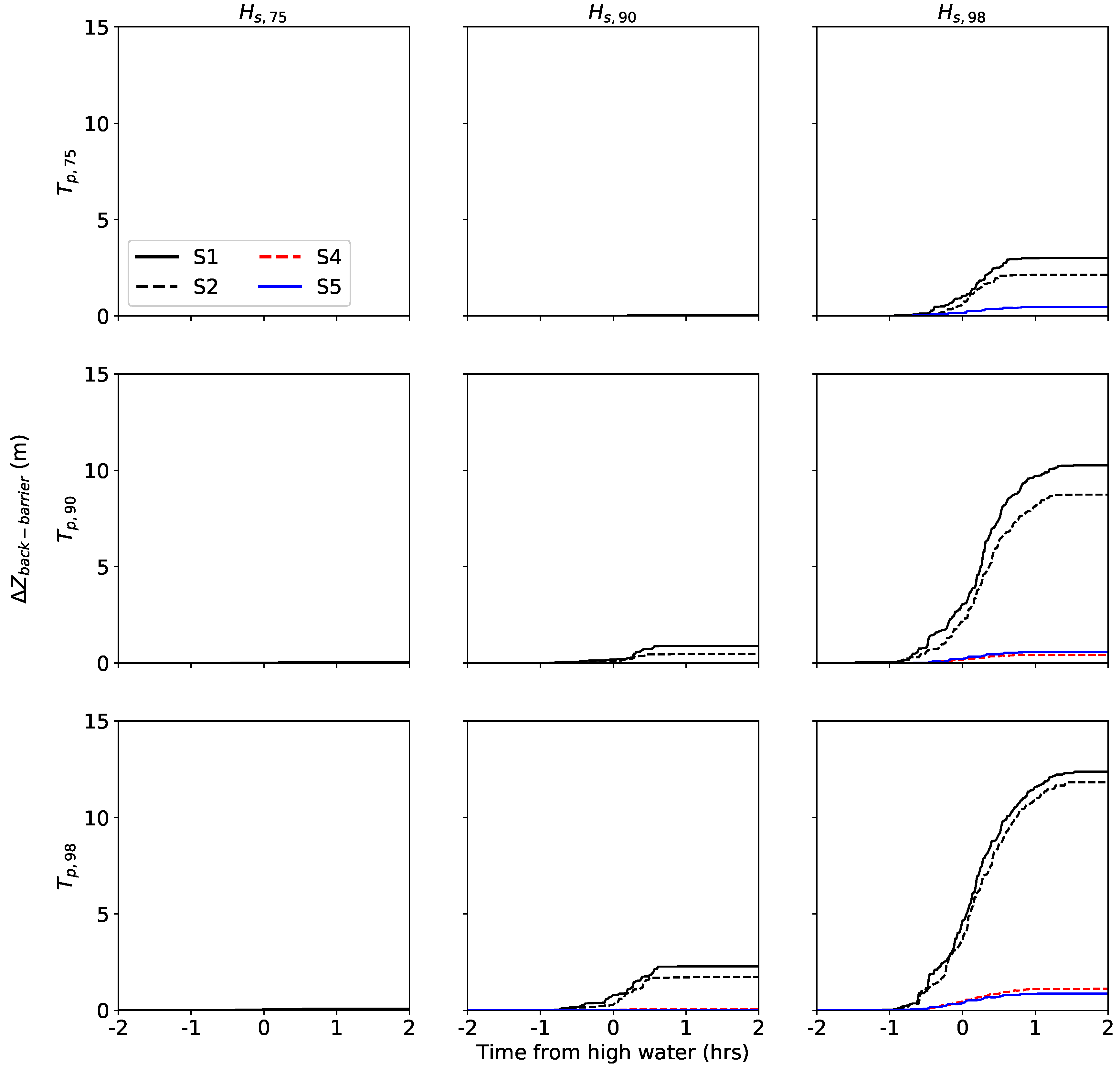
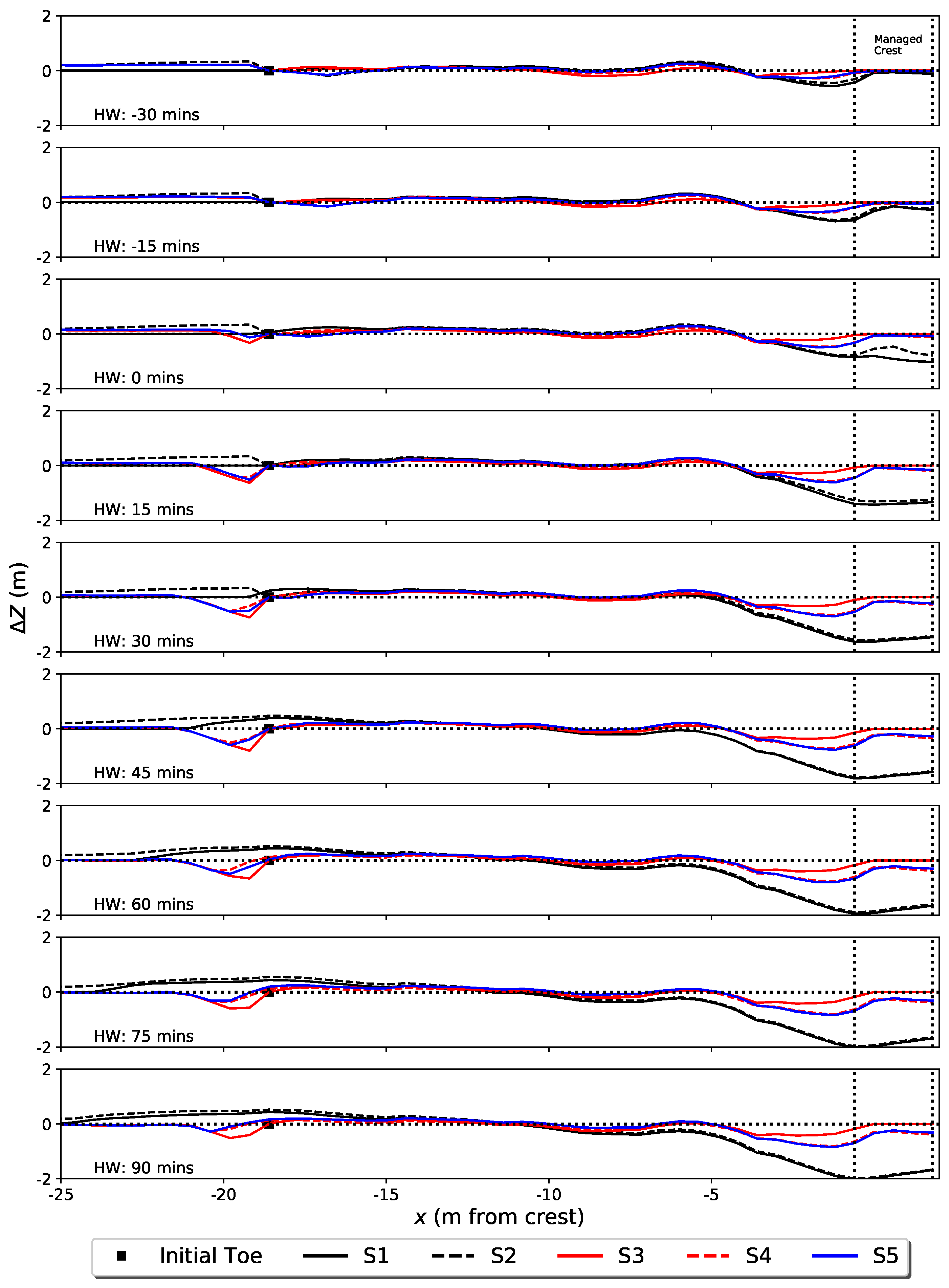
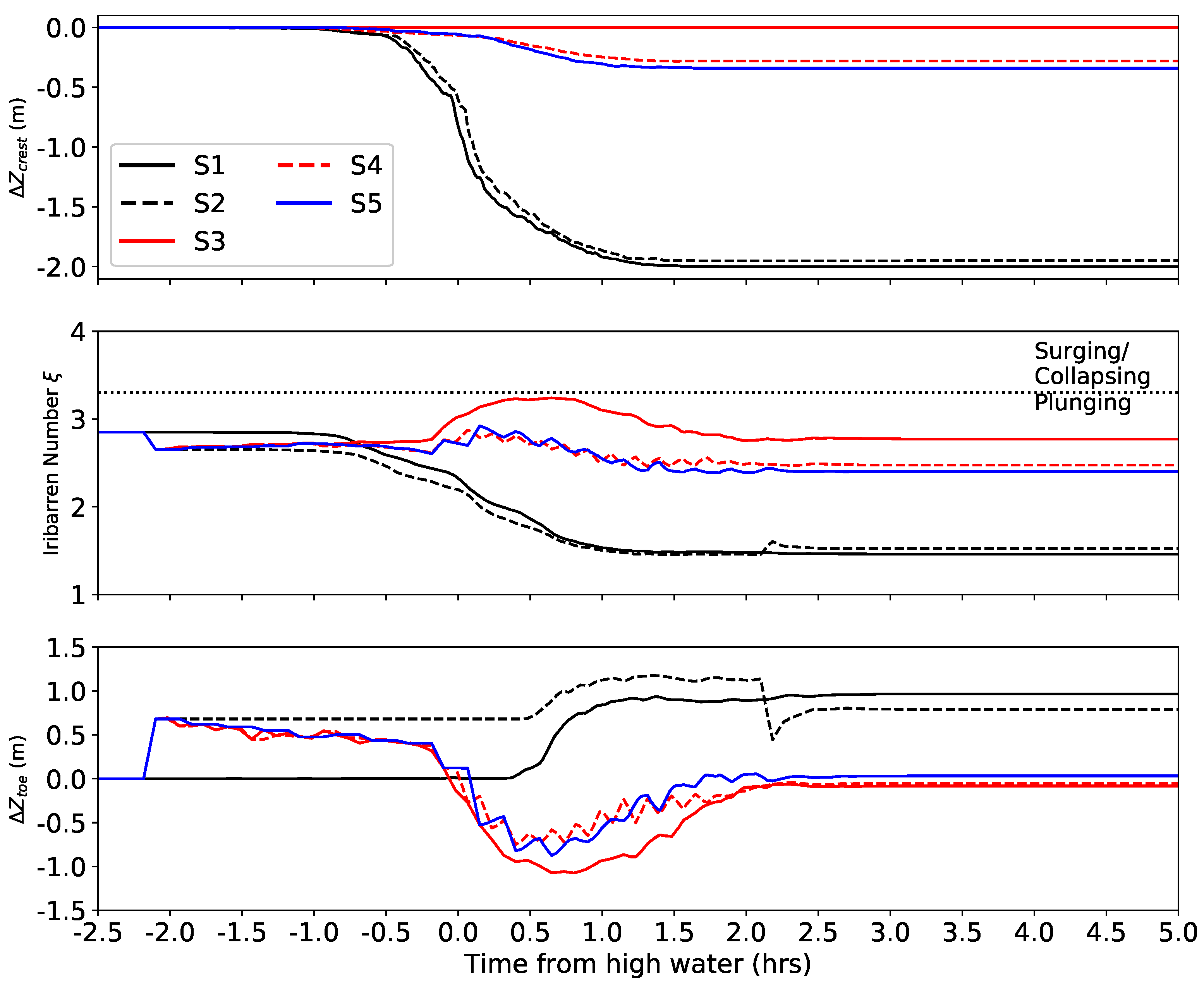
| Policy Unit | 0–20 Years | 20–50 Years | 50–100 Years | Intention |
|---|---|---|---|---|
| 2.11 | MR | MR | NAI | Manage shingle on the road with the long-term intent of allowing the gravel barrier to behave naturally |
| 2.12 | MR | MR | MR | Manage the cliffs and stream position to sustain the upper village |
| Scenario | () | () |
|---|---|---|
| 1 | 0.36 () | 5.52 () |
| 2 | 0.94 () | 5.52 |
| 3 | 1.50 () | 5.52 |
| 4 | 2.18 () | 5.52 |
| 5 | 3.56 () | 5.52 |
| 6 | 0.36 | 9.52 () |
| 7 | 0.94 | 9.52 |
| 8 | 1.50 | 9.52 |
| 9 | 2.18 | 9.52 |
| 10 | 3.56 | 9.52 |
| 11 | 0.36 | 11.49 () |
| 12 | 0.94 | 11.49 |
| 13 | 1.50 | 11.49 |
| 14 | 2.18 | 11.49 |
| 15 | 3.56 | 11.49 |
| 16 | 0.36 | 13.33 () |
| 17 | 0.94 | 13.33 |
| 18 | 1.50 | 13.33 |
| 19 | 2.18 | 13.33 |
| 20 | 3.56 | 13.33 |
| 21 | 0.36 | 15.15 () |
| 22 | 0.94 | 15.15 |
| 23 | 1.50 | 15.15 |
| 24 | 2.18 | 15.15 |
| 25 | 3.56 | 15.15 |
| Scenario | Description |
|---|---|
| S1 | There is no updating of the foreshore evolution. The initial, sandy foreshore shown in Figure 5 remains static throughout the simulation. |
| S2 | The foreshore is updated twice according to the evolved profile at the equivalent point in time from the XBeach-X outputs with the sandy settings enabled and the gravel barrier assigned as non-erodible. The first update occurs when the water level exceeds the barrier toe ( m ODN) on the flood tide. The second and final update occurs when the water level recedes below the barrier toe on the ebb tide. |
| S3 | As S2, but additional foreshore updates occur every 5 min while the water level exceeds the barrier toe. |
| S4 | As S2, but additional foreshore updates occur every 10 min while the water level exceeds the barrier toe. |
| S5 | As S2, but additional foreshore updates occur every 15 min while the water level exceeds the barrier toe. |
| Foreshore Evolution Setting | Mean Barrier Erosion (m) | Mean Land Sedimentation (m) |
|---|---|---|
| S1 | −0.79 | 1.17 |
| S2 | −0.71 | 1.00 |
| S3 | 0.00 | 0.00 |
| S4 | −0.07 | 0.06 |
| S5 | −0.11 | 0.08 |
Publisher’s Note: MDPI stays neutral with regard to jurisdictional claims in published maps and institutional affiliations. |
© 2020 by the authors. Licensee MDPI, Basel, Switzerland. This article is an open access article distributed under the terms and conditions of the Creative Commons Attribution (CC BY) license (http://creativecommons.org/licenses/by/4.0/).
Share and Cite
Phillips, B.T.; Brown, J.M.; Plater, A.J. Modeling Impact of Intertidal Foreshore Evolution on Gravel Barrier Erosion and Wave Runup with XBeach-X. J. Mar. Sci. Eng. 2020, 8, 914. https://doi.org/10.3390/jmse8110914
Phillips BT, Brown JM, Plater AJ. Modeling Impact of Intertidal Foreshore Evolution on Gravel Barrier Erosion and Wave Runup with XBeach-X. Journal of Marine Science and Engineering. 2020; 8(11):914. https://doi.org/10.3390/jmse8110914
Chicago/Turabian StylePhillips, Benjamin T., Jennifer M. Brown, and Andrew J. Plater. 2020. "Modeling Impact of Intertidal Foreshore Evolution on Gravel Barrier Erosion and Wave Runup with XBeach-X" Journal of Marine Science and Engineering 8, no. 11: 914. https://doi.org/10.3390/jmse8110914





